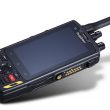Wi-Fi wins friends among vendors
For a time, wireless carriers saw Wi-Fi as an annoyance — a competing technology that interfered with their plans to bring 3G to the masses. But in the past year, carriers and wireless industry vendors have changed their tune. Wi-Fi is no longer just an enterprise technology or a coffee shop gimmick. The standard has gained momentum and is finally driving some carriers and vendors to take the technology seriously.
Several vendors have made announcements over the past few weeks concerning their efforts to fit Wi-Fi into the basic infrastructure of the wide area wireless network. Their goal is to allow carriers to run Wi-Fi subscribers like any other data customer on the network and, in most cases, to allow roaming between their 2.5G and 3G mobile data offerings and Wi-Fi enterprise networks and hot spots.
“We’ve been getting overwhelmed with customer requests,” said Bill Howe, CEO of Mobility Networks, a Wi-Fi equipment vendor that has developed a solution to integrate Wi-Fi with GSM networks. “Among mobile operators, there’s a growing realization that you need to be in Wi-Fi. If you don’t get there first, somebody else will.”
Mobility and Nortel Networks have teamed up to develop a Wi-Fi/GSM-GPRS network infrastructure, which they deployed for the first time this month in Malta for Italy’s Go Mobile. The solution tracks the carrier’s Wi-Fi users the same way it does GPRS users, no matter how much they meander between Go Mobile’s array of hot spots and its WAN.
Nortel sees Wi-Fi as a crucial part of future network architectures. Despite earlier fears that Wi-Fi could undermine 3G in the data wars, Nortel is now completely comfortable that the two technologies will complement each other on the same network.
“We realized that Wi-Fi was going to be a hot spot technology — it’s very location-specific, and it’s not designed to work in a wide area setting,” said Mark Morrell, Nortel’s director of strategic marketing for wireless networks.
Deploying Wi-Fi on a mobile network “gives us the opportunity to have the best-case scenario in every situation.”
Wireline carriers began to seriously explore Wi-Fi a few months ago but have not integrated the technology with any wide area wireless offering. Instead, Verizon Communications announced it would sell Wi-Fi with its broadband offerings, and AT&T — along with Intel, IBM and a venture capital firm — formed Cometa. And with the exception of T-Mobile, wireless carriers seem much more reluctant to get into the game.
Even T-Mobile, which owns MobileStar’s 802.11b assets, has not yet delineated a plan for integrating its Wi-Fi and GPRS networks, but the carrier is in discussions with vendors, including Nortel.
Other mobile infrastructure vendors are jumping into the Wi-Fi pool as well, but they’re testing the waters before they do. Both Lucent Technologies and Motorola are developing solutions that integrate Wi-Fi with their networks.
But rather than focusing on carriers, both vendors are focused on enterprise customers.
“We’re trying to focus on where the real money is for customers, and the public hot spot model is relatively risky for a wireless carrier,” said Maria Palamara, a director in Lucent’s enterprise data group. “It makes more sense for a Cometa with AT&T or a Verizon to run a network like that. They already have the data infrastructure in place.”
Motorola, Avaya and Proxim also announced a partnership last week to develop technologies that will allow seamless roaming between the mobile and Wi-Fi networks. But like Lucent and Motorola, they are focusing on enterprise customers, which will be responsible for establishing their own deals with carriers, buying minutes off their networks.
Regardless of whether WAN/Wi-Fi integration starts with the carrier or with enterprise customers, it won’t be long before every carrier is involved, either installing equipment in their own networks or through roaming agreements with Wi-Fi ISPs, Mobility’s Howe said.
“I predict that by the end of the year, every major carrier will have at least a pilot program in place, and many will have hundreds of hot spots deployed,” Howe said.
Kevin Fitchard is a staff writer for Telephony, our sister publication.












